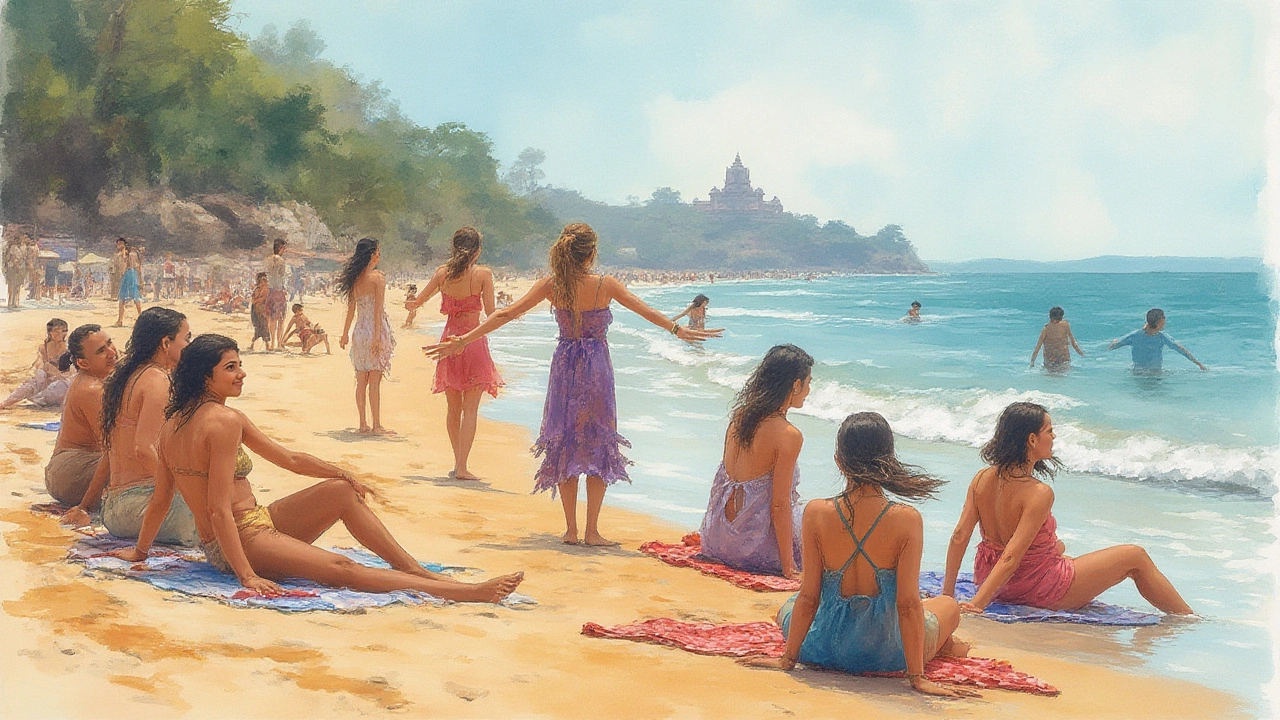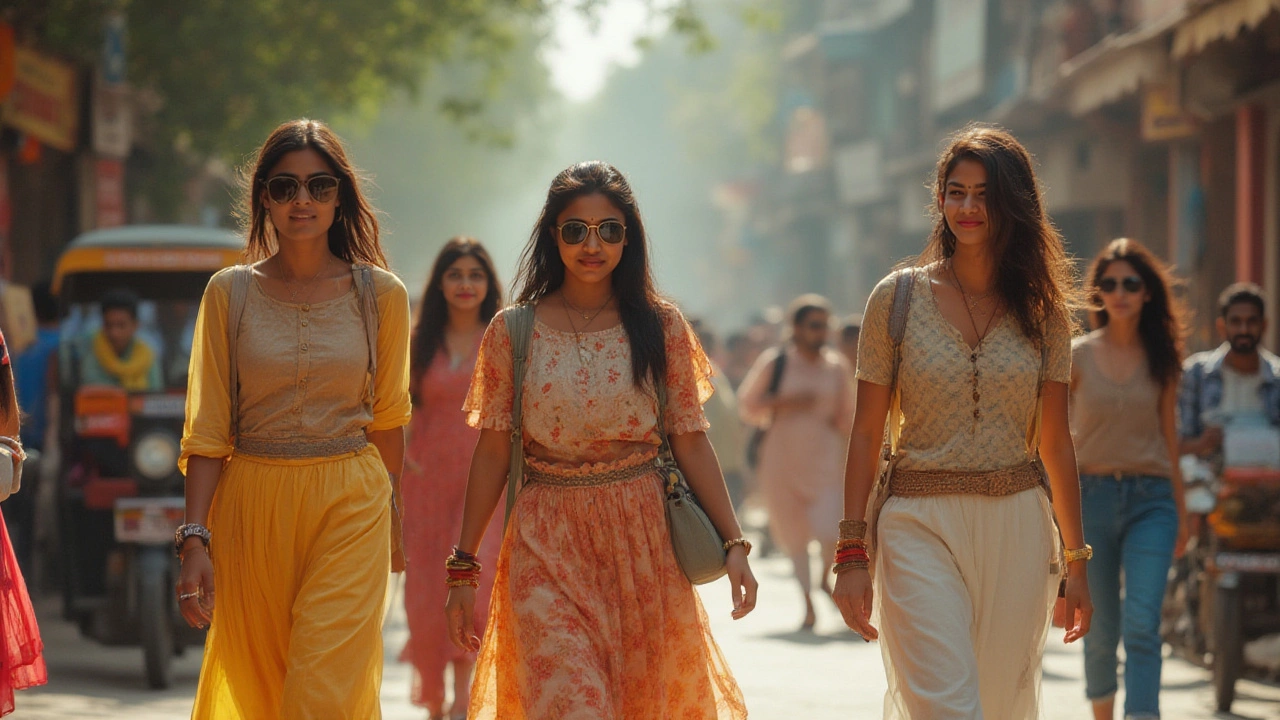Ask anyone who’s researched travel to India, and clothing comes up fast. No matter if you’re window-shopping in Mumbai or heading to a South Indian wedding, that nagging question pops up: can I show my legs in India or will I stick out like a sore thumb? Here’s the short answer—it depends a lot on where you go, what you’re doing, and how deep you want to dive into the local scene. The country is massive, and what flies in one place might get you odd looks somewhere else. If you’ve seen photos of Bollywood celebs or urban Instagrammers in miniskirts, you might think the rules are wide open. But reality on the ground is layered, and not everyone dances to the same tune.
The Diversity of Indian Dress Culture
Step off your flight in Delhi or Bengaluru, and you’ll spot people in all kinds of clothes. It’s not a uniform system, and that’s the first thing most visitors notice. You’ll see college girls in ripped jeans, women in classic saris, men in shorts and T-shirts, and sometimes all of them walking the same street. India might be one country, but its dress codes come in a dozen flavors—urban, rural, modern, traditional, north, south, east, west. Cities like Mumbai, Delhi, and Goa are known for their chilled-out, cosmopolitan attitude. Plenty of locals and tourists wear shorts, skirts, and dresses without much fuss, especially in areas with nightlife or lots of travelers.
Venture outside those cities, though, and you’ll watch the mood shift. In smaller towns and villages, people lean more traditional, especially in the heartlands of Uttar Pradesh or Rajasthan. Here, you might spot women in long skirts (lehenga or ghagra) and a dupatta over their head. Modesty tends to matter the further you get from big urban centers, and showing your legs—especially thighs—gets rarer for women and sometimes even for men over a certain age. Young urban guys can often be seen in shorts, but middle-aged and older men may prefer trousers as a sign of respectability. Rural women almost never wear anything above the knee.
It isn’t just about old versus young, or city versus country. Religion, region, and even season play a role here. In Kerala, for example, local men have worn short dhotis (mundu) for generations, and nobody bats an eye. And let’s point out the coast: beaches in Goa, Kerala, Pondicherry, and Mumbai have chilled vacation vibes, so shorts and swimsuits don’t turn heads. But ten kilometers inland, the mood might flip. Western clothes are gaining ground everywhere, but tradition has deep roots in daily life, weddings, festivals, and religious places.
Where It’s Acceptable (And Where To Think Twice)
If you’re looking for black-and-white rules, you’re out of luck. But here’s where showing your legs isn’t a big deal:
- Tourist hotspots – Beach towns like Goa, Gokarna or certain parts of Pondicherry are used to people in shorts, sundresses and swimsuits.
- Mega-cities – In Mumbai, Bengaluru, Hyderabad and Delhi, young locals and visitors often wear shorts, skirts, and dresses. Upscale shopping malls, cafes or bar districts are pretty relaxed.
- Private clubs or resorts – International hotels, resort pools, and private clubs generally don’t care as long as you’re not in public areas outside.
But there are places where it’s better to cover up:
- Temples, mosques, gurdwaras, and other religious sites – No matter your gender or where you’re from, legs (and usually arms) should be covered. In some Hindu temples in South India, men need to wear a sarong-like dhoti, and can’t enter in pants or shorts.
- Government offices and schools – These spaces expect a modest dress code. Locals will side-eye you for showing thighs or knees here.
- Small towns and villages – You’ll get more stares if you flash a lot of skin, especially for women. It might not be dangerous, but it gets uncomfortable fast. Some folks will think it’s disrespectful, especially towards elders.
- Traditional family events - If you’re invited to a wedding or religious gathering, legs and shoulders should stay covered—midis or maxis are safer bets.
Height of summer? Yes, it can get sweaty—temperatures above 40°C (104°F) are common in many cities from April to June. No one will judge you for wanting lighter clothes, but you’ll notice many Indian women still manage with leggings, loose cotton pants, kurtas, or long skirts even in the heat. Men do tend to switch to shorts if they’re under 30-35—older men mostly stick to full trousers or lungis (loose wraparounds).
| Region | Shorts/Short Skirts | Leggings/Maxi Skirts |
| Mumbai, Delhi, Bengaluru | Common | Common |
| Goa, Pondicherry beaches | Very common | Common |
| Jaipur, Varanasi, Agra | Occasional | Very common |
| Villages (North/South) | Rare | Most common |
Some of the most-visited tourist spots enforce extra dress codes. The Taj Mahal, for example, recommends conservative dress for photos (though there are no strict checks). Most famous temples provide or rent out wraps for visitors who aren’t covered up. No one is forced, but it saves you stares and awkwardness.

Gender, Age, and Perceptions: Why It’s Complicated
Okay, here’s where it gets interesting. There’s no national law in India about showing your legs, but public attitudes can be intense. For men, a pair of knee-length shorts for a morning walk isn’t weird, but walking into an office or temple that way? You’d stand out. Western men in big cities can wander around in shorts without serious problems, but younger locals are more likely to do the same. Older men tend to stick with pants—not because they have to, but because old habits die hard.
For women, it’s a balancing act between personal comfort, safety, and blending in. In cities, you’ll see college students and working women of all backgrounds in dresses and skirts. But knee-length and above is still less common outside party scenes or younger crowds. If you’re foreign, you’ll get less flak than Indian women might, but sometimes that means extra attention. And yes, it can go both ways—some Indian women say that wearing modest Indian clothing actually gives them more confidence and less hassle.
There’s data out there too. A 2023 survey by Local Circles across seven large Indian cities noted that over 70% of young urbanites felt comfortable with women wearing shorts or skirts in malls, cafes, or parties. But only 25% felt it was cool in public transport or the average market. In rural India, opinions can be even stickier. A large percentage of incidents of "eve teasing"—a catch-all for street harassment—relate to perceived violations of local dress codes, though it happens to women in all sorts of clothes.
It’s not just about staring or gossip. Like everywhere else, some people associate modest dress with respectfulness; for others, it’s simply habit. Foreign visitors are sometimes put on a pedestal (which can mean a pass in social situations), but it’s a double-edged sword if you hate being the center of attention. Blend in, and you lower the volume on curious eyes; stand out, and it’s just part of the cultural exchange. People gossip in small towns, and clothing choices can get passed through the grapevine faster than WhatsApp forwards.
At the same time, things are changing quickly. Feminist campaigns, social media, and pop culture have made city centers much more open to fun, daring styles. The biggest growth in the fashion retail market? Women under 30, and brands know it. Yet, flip to primetime news and you’ll still find debates about ‘appropriate’ clothing triggered by celebrity posts. It’s modern India in a nutshell—tradition and experimentation living side by side, not always peacefully, but definitely vibrantly.
Tips to Dress Confidently and Comfortably
Ready to pack your bags? Here’s what makes life easier for anyone wondering about legs, shorts, and blending in across India:
- Layer up – If you want to try shorts or skirts, carry a lightweight scarf or long shirt to toss on when you feel exposed. It works like magic in awkward moments.
- Stick to knee-length or longer – Anything too short gets more stares, especially on local transport. Midi dresses or capri pants are perfect.
- Observe and copy
- When in doubt—copy what young locals are wearing in the neighborhood. At tourist hangouts, dress as you please. At temples, play it safe with full-length pants or skirts.
- Loose trumps tight – Flowy skirts, breezy palazzos, and relaxed shorts keep you cool without raising eyebrows.
- Mind the context – On a jungle hike or by the hotel pool, go wild. At a wedding or rural homestay, choose tradition—salwar kameez or trousers (men), long skirts or comfortable gowns (women).
- Colors matter – Loud prints and neon shades are loved in India, but darker colors can help if you’re worried about transparency or sweat patches.
- Material matters – Cotton and linen are your friends. Avoid heavy denim; it’s misery in Indian summers.
- Pockets rock – Pockets in dresses or shorts keep your hands free, and you’ll always need quick access to your phone, cash, or sanitizer.
- Footwear counts – Flip-flops work in most casual spots, but some temples and certain restaurants may expect closed shoes or sandals.
Here’s a checklist that real travelers swear by when packing for India, especially if you're not sure how much leg is too much leg:
- 1-2 pairs of knee-length or longer shorts
- 1-2 long skirts or flowy pants
- Light scarves for quick coverage
- Tops that cover shoulders and aren't too clingy
- 1 set of more modest outfits for special visits (temples, countryside)
- 1-2 fun, bold outfits for city nights out
Always have Google Maps handy to scope out nearby malls and stores—fashion in India is cheap and creative, and you might end up buying more than you bring. Most big cities have brands offering all styles, from traditional to ultra-modern. If you do get a stare or a comment, shrug it off—it’s rarely aggressive. Smile, show respect, and keep moving. Remember, *showing your legs in India* is less about hard rules and more about reading the room. Confidence with a sprinkle of practical sense goes a long way.
